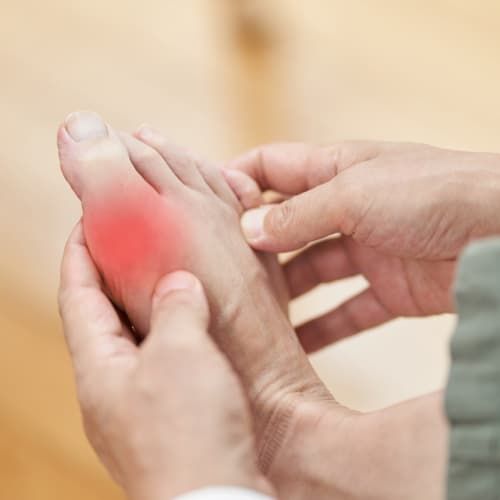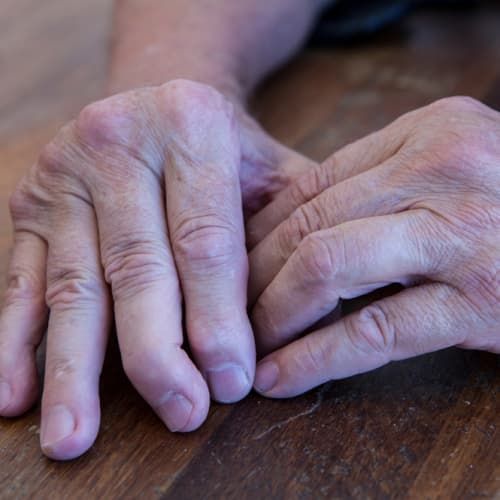If you have arthritis, you may feel frustrated, hopeless, and isolated. Arthritis is a common condition affecting about 258 million1 people worldwide, so you’re not alone!
Arthritis can make your life harder. It causes symptoms like pain, stiffness, and swelling, and limits your movement.
In recent years, there’s been increasing interest in the role of lifestyle factors in managing arthritis. One main interest is how diet and exercise affect arthritis. In this article, we’ll discuss some of the latest scientific evidence surrounding diet and exercise in managing arthritis. We’ll also give you some practical advice on making simple lifestyle changes to help manage your arthritis symptoms and improve your quality of life.
What is Arthritis?
Arthritis is a broad term that refers to a group of conditions that affect the joints and surrounding tissue. There are more than 100 different types of arthritis, but the most common types include:
Symptoms of arthritis2 differ depending on the type but commonly include:
- Pain
- Swelling
- Stiffness
- Weakness
- Loss of function
- Joint deformity
- Joint instability
The underlying cause3 depends on the type of arthritis:
- Osteoarthritis is caused by overuse or wear and tear of your joints over time.
- Rheumatoid and psoriatic arthritis happen when your immune system mistakenly attacks your joints, cells, and body tissues.
- Gout is caused by the buildup of crystals in your joints.
What’s the Connection Between Arthritis and Inflammation?
The exact cause of inflammation in arthritis4 isn’t fully understood. But inflammation plays a big role in causing arthritis. This happens because of a mix of genes, the immune system, and the environment around us.
Current Treatments for Arthritis and Their Limitations
Doctors use a variety of medications to treat arthritis, depending on the type and severity of the disease.
Below are some common medications for treating arthritis. As with any medication, they carry a risk of side effects.5
- Non-steroidal anti-inflammatory drugs (NSAIDs) – side effects include stomach irritation and an increased risk of stroke or heart attack.
- Corticosteroids – side effects include weight gain, diabetes, and bone thinning.
- Disease-modifying anti-rheumatic drugs (DMARDs) – side effects vary, but most increase the risk of infection.
- Biologic agents -common side effects include increased risk of infection, re-activation of Hepatitis B or tuberculosis infection, and allergic reactions.
Surgeons can sometimes treat arthritis that is not responsive to conservative treatment options. There are various types of surgery depending on which joint is affected. Common surgical options include:
- arthroscopy
- joint fusion
- joint replacement
Full recovery from surgery can take up to 6 months. A complete rehabilitation program after surgery is necessary for optimal healing.
Does Diet Affect Arthritis? What History Tells Us About Diet and Arthritis
For centuries,6 people have looked at how diet helps manage arthritis. Long ago, Hippocrates thought some foods could cause or fix joint pain because of “wind” or “phlegm.” Later, Galen said to avoid foods that make more phlegm, which scientists thought caused arthritis, and eat foods that reduce it.
Nowadays, modern science provides more proof of how diet helps with arthritis. We’ve learned much about vitamins, minerals, antioxidants, phytochemicals, and other nutrients that impact health and sickness.
In recent years, many studies have shown how diet affects arthritis management.Evidence shows certain foods can do the following:
- increase or reduce inflammation in the body
- modulate the immune system
- affect the metabolism and functioning of joints
Arthritis Foods to Avoid
There are a variety of arthritis foods to avoid,7 including the following:
- High-purine foods, including anchovies, asparagus, dried peas, beans, and alcohol. These foods increase uric acid production, increasing joint pain and swelling.
- Refined carbohydrates, including white bread and pastries, fried foods, sugar-sweetened drinks, including soda, processed and red meats, margarine, shortening, and lard. These foods trigger inflammation in the body and exacerbate arthritis symptoms.
- Hydrogenated or partially hydrogenated oils. Foods containing these types of oils can trigger inflammation in the body and also increase the risk of cardiovascular disease.
- Processed flour, added sugar, and high fructose corn syrup. Foods that contain these ingredients raise blood sugar levels and cause oxidative stress, which can damage cells and tissues in the body.
Foods that May Help Your Arthritis
An arthritis inflammation diet should include a variety of arthritis-friendly foods,7 including:
- Omega-3 fatty acids, including fatty fish, walnuts, chia seeds, soybeans, and flaxseeds, have anti-inflammatory properties and can help to decrease joint pain and stiffness.
- Fruits and vegetables that are high in antioxidants, vitamins, minerals, and fiber, including berries, cherries, grapes, citrus fruits, leafy green vegetables, broccoli, cabbage, and cauliflower, help to protect the cells of the body from inflammation and damage. Additionally, they also have phytochemicals, which have anti-inflammatory properties.
- Whole grains and legumes, including oats, barley, quinoa, brown rice, lentils, beans, and peas, provide complex carbohydrates, fiber, protein, and phytochemicals that help to decrease blood sugar levels and inflammation. Additionally, they provide essential nutrients, including zinc, magnesium, folate, and selenium, to support immune function and optimal joint health.
- Herbs and spices, including turmeric, ginger, garlic, rosemary, onion, thyme, basil, oregano, and cinnamon, can add flavor to your food while also providing you with antioxidants and anti-inflammatory compounds that can help to optimize your immune system and decrease inflammation.
Arthritis Diet and Exercise
There are many health benefits8 of exercise for arthritis, including:
- Increasing your range of motion and decreasing stiffness, which helps to improve joint mobility and flexibility.
- Strengthening muscles that support the joints, which helps to improve joint stability and decrease stress on the joints.
- Improving cardiovascular fitness, which helps to improve overall health and well-being. This is an important point, as improved overall health can help you cope with inflammation, fatigue, and depression.
Three main types of exercise8 should be included in an arthritis exercise program:
- Range of motion exercises
- Strengthening exercises
- Cardiovascular exercises
The Big Question – Can Arthritis be Reversed?
Can Arthritis Be Reversed by Diet?
You might be asking yourself, can arthritis be reversed by diet? Diet helps manage arthritis but can’t reverse the damage to joints or cure the condition.
Can Diet Affect Arthritis Pain?
Making some dietary changes can help to reduce inflammation, pain, and stiffness caused by arthritis. Natalie McCormick, a research fellow in medicine at Harvard Medical School, states that “diet can be part of disease management.”9
Practical Steps for Lifestyle Changes
Creating an Arthritis-Friendly Diet Plan
If you’re looking for an arthritis inflammation diet, consider the Mediterranean diet or the DASH diet. Researchers believe both of these diets have anti-inflammatory benefits9.
Here are some tips to help you stick to an arthritis inflammation diet:
- Set small and realistic goals.
- Use a food diary or app to track your food consumption.
- Plan and prepare your meals ahead.
Crafting an Exercise Regimen
If you’re new to exercise, talking to a physical therapist or trainer can help you make a workout plan that fits your abilities and goals.
Below, we’ll give a brief example of 10-minute beginner, intermediate, and advanced exercise plans for arthritis.
Beginner
- Warm up with a brisk walk, slow jog, or cycle for 2 minutes.
- Perform at least 2 stretches – arm circles, side bends, etc.
- Perform the following exercises with 3 sets of 10 repetitions, resting for about 30 seconds between each set:
- Wall push-ups
- Chair squats
- Bicep curls
- Overhead presses
- Cool down with a brisk walk for 2 minutes.
Intermediate
- Warm up with a brisk walk, slow jog, or cycle for 2 minutes.
- Perform at least 2 stretches – standing hamstring stretch, standing quad stretch, etc.
- Perform the following exercises with 3 sets of 10 repetitions, resting for about 30 seconds between each set:
- Lunges
- Shoulder presses
- Bridge
- Bird-Dog
- Cool down with a brisk walk for 2 minutes.
Advanced
- Warm up with a brisk walk, slow jog, or cycle for 2 minutes.
- Perform at least 2 stretches – lying hamstring stretch, ankle circles, etc.
- Perform the following exercises with 3 sets of 10 repetitions, resting for about 30 seconds between each set:
- Bridge with leg extension
- Step-ups
- Leg press with resistance band
- Seated knee lift with resistance band
- Cool down with a brisk walk for 2 minutes.
Tips for exercising safely include:
- Consult your healthcare practitioner before starting a new exercise program.
- Warm-up and cool down before and after exercise.
- Start slowly and gradually increase the intensity of your program.
- Include a variety of exercises (flexibility, strengthening, and cardiovascular) in your program.
- Ensure you breathe while exercising.
- Listen to your body and rest when you need to.
Takeaway
Being diagnosed with arthritis can make you feel frustrated. Remember that you’re not alone.
As discussed in this article, following an arthritis diet and exercise program can help you manage arthritis symptoms by decreasing inflammation, pain, and stiffness. Also, making simple lifestyle changes can help you take control of your arthritis and improve your quality of life.


















I just wanted to take a moment to express my gratitude for the great content you consistently produce. It’s informative, interesting, and always keeps me coming back for more!
Thank you for the awesome content, it’s always appreciated